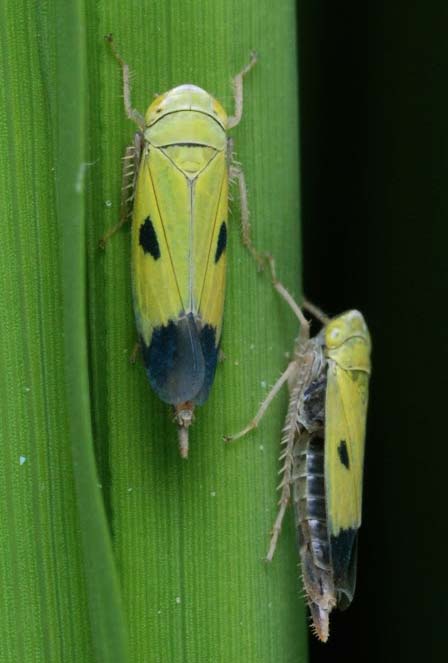Green leafhopper
Two species of green leafhoppers (GLH) can spread tungro: Nephotettix malayanus and Nephotettix virescens.

What it does
Green leafhoppers are the most common leafhoppers in rice fields and are primarily critical because they spread the viral disease tungro. Both nymphs and adults feed by extracting plant sap with their needle-shaped mouthparts.
Why and where it occurs
Staggered planting encourages population growth of GLH.
Green leafhoppers are common in rainfed and irrigated wetland environments. They are not prevalent in upland rice. Both the nymphs and adults feed on the dorsal surface of the leaf blades rather than the ventral surface. They prefer to feed on the lateral leaves rather than the leaf sheaths and the middle leaves. They also prefer rice plants that have been fertilized with large amount of nitrogen.
How to identify
Rice fields infested by GLH can have tungro, yellow dwarf, yellow-orange leaf, and transitory yellowing diseases.
Symptoms include:
- stunted plants and reduced vigor
- reduced number of productive tillers
- withering or complete plant drying
Tungro infected crops may sometimes be confused with nitrogen deficiency or iron toxicity or acid soils. To confirm the cause of the problem, check for virus infected plants in the fields, and the presence of the insect:
- white or pale yellow eggs inside leaf sheaths or midribs
- yellow or pale green nymphs with or without black markings
- pale green adults with or without black markings feeding on upper parts of the crop
Why is it important
Green leafhoppers are important pests. They are vectors of viral diseases such as tungro, yellow dwarf, yellow-orange leaf, transitory yellowing, and dwarf.
How to manage
- Use GLH-resistant and tungro-resistant varieties. Contact your local agriculture office for an up-to-date list of available varieties.
- Reduce the number of rice crops to two per year and synchronized crop establishment across farms reduces leafhoppers and other insect vectors.
- Transplant older seedlings (>3 weeks) to reduce viral disease susceptibility transmitted by leafhoppers.
- Plant early within a given planting period, particularly in the dry season to reduce the risk of insect-vector disease.
- Avoid planting during the peak of GLH activity (shown by historical records) to avoid infestation. Light traps can be used to show GLH numbers.
- Apply nitrogen as needed (e.g., using the Leaf Color Chart) to avoid contributing to population outbreaks by applying too much nitrogen, or hindering plant recovery from planthopper damage by applying insufficient nitrogen.
- Control weeds in the field and on the bunds to remove the preferred grassy hosts of GLH and promotes crop vigor.
- Perform crop rotation with a non-rice crop during the dry season to decrease alternate hosts for diseases.
- Intercrop upland rice with soybean to reduce the incidence of leafhoppers on rice.
In areas without tungro source, insecticides are not needed, avoid spraying of insecticide (it is often unable to prevent or reduce tungro infections).
Encourage biological control agents: small wasps (parasitize the eggs), mirid bug; strepsipterans, small wasps, pipunculid flies, and nematodes (parasitize both the nymphs and adults), aquatic veliid bugs, nabid bugs, empid flies, damselflies, dragonflies, and spiders, fungal pathogen (attacks both nymph and adult).







